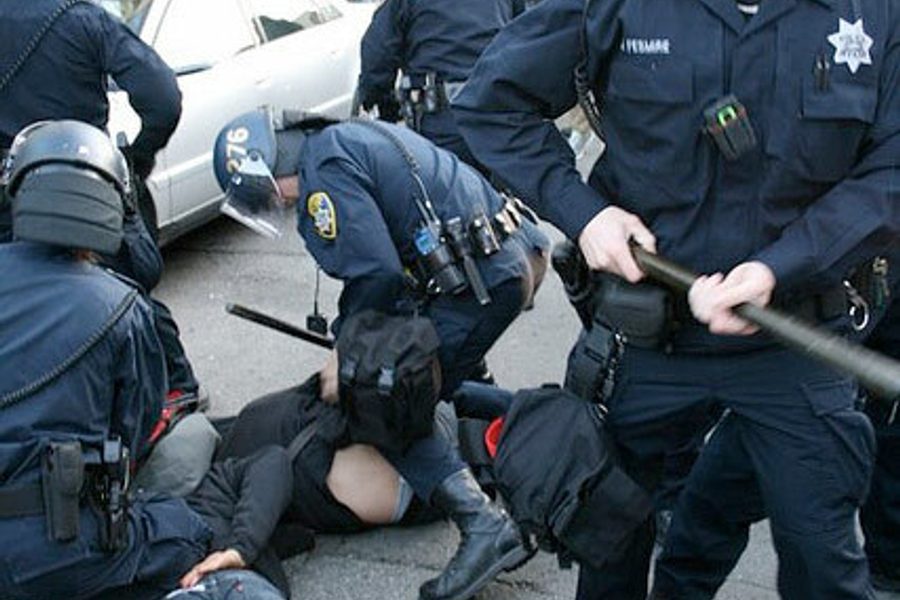
For most occupations around the country, police brutality and mass arrests at political protests are new. For Oakland, they’re all too familiar.
Last November, protests against the light sentence handed down to BART police officer Johannes Mehserle after he shot and killed an unarmed Oscar Grant led to mass arrests even greater than the ones Occupy Oakland has seen thus far. The vast majority of charges against those protesters were never filed or dismissed, and the arrestees were left in a sort of limbo state for the misdemeanor’s statute of limitations, not knowing if today was the day a letter to appear might in court come in the mail.
That year-long limbo ended four days after 101 protesters were arrested just north of the encampment at Frank H. Ogawa Plaza, renamed Oscar Grant Plaza, in a police action in the early morning of November 3.
In theory, a few hundred misdemeanor arrests should be no problem for a city of nearly half a million to handle. In theory, arrestees should be “cited out” efficiently and assigned arraignment dates in the court’s next opening, when the district attorney should, in theory, have made a decision about whether or not to file charges in the cases.
The right to a speedy trial afforded to Americans charged with crimes only applies when Americans are in fact charged with those crimes. In Occupy arrests both in Oakland and elsewhere, this is often not the case.
In Los Angeles, nearly 300 occupiers arrested during the raid on their encampment were held for the maximum 48 hours allowable by law before being released without arraignment. Charges against many of the arrestees were later dropped.
In New York, some of the more than 700 occupy Wall Street protesters who were arrested on October 1 on the Brooklyn Bridge accepted a deal wherein their charges would be dismissed in six months if they were not arrested again. A smaller number who pled not guilty at their arraignments face the possibility of trial.
In Sacramento, charges were dropped against the vast majority of arrested protesters. The remaining nine rejected a plea deal from the city — a $100 fine and six hours of community service — and now face up to six months in jail if convicted.
Oakland’s Alameda County has a history of keeping political protesters arrested for the misdemeanor charge “failure to leave the scene of a riot,” otherwise known as “unlawful assembly,” in a sort of statutory limbo. At their arraignment dates this week, dozens of Occupy Oakland arrestees were told charges had not been filed against them, but neither had those charges been dropped.
When the District Attorney tells the National Lawyer’s Guild that they are still investigating the arrests, this is not strictly true. To date, the Oakland Police Department has not completed its reports for those arrested in the plaza raids October 25 and November 3. “We’re still pulling that all together,” OPD public information officer Johnna Watson told me. “It’s a lot of paperwork.”
Paperwork of which, according to Alameda County Deputy District Attorney Teresa Drenick, the DA’s office has yet to see one piece.
“In the Bay Area, this is fairly common in mass arrest situations,” says Carlos Villarreal, executive director of the National Lawyer’s Guild San Francisco chapter. In metropolitan areas with rich histories of protest such as the Bay Area, an undeniable political dynamic is also at play. “If there’s political capital behind prosecuting somebody, my sense is that probably that’s what they’re going to put energy into.”
“The tactic is they’re not going to bother prosecuting these hundreds of people, but they want to pick and choose individuals — dig through and develop the evidence on the those few people that they think they have a chance at charging.”
In San Francisco, however, city prosecutors have been sending more and more misdemeanor protest offenders to traffic court, charging them with infractions as opposed to criminal misdemeanors. “It’s a way of prosecuting the cases and disposing of them in a way that’s efficient,” Villarreal says.
The process across the bay in Oakland seems to be anything but. When arrestees inquired with the DA’s office as to how they might be kept abreast if charges are filed against them in the future, the DA informed them to “call back every week” for the next year. When arrestees inquired about changing their addresses so the DA might be better able to reach them in the future, they were told there was no way of doing so.
“That could just be bureaucracy, but my guess is they’re not very motivated to solve that problem,” Villarreal says.
Above all else, this seems to be the clincher: bureaucracy that no one with power is motivated to cut through. Like so many aspects of the law enforcement surrounding Occupy, it can be difficult to know what results from true malice and what results from institutional disorganization and incompetence. The fact that the number of arrests in comparison to the population and municipal infrastructure of Oakland and governing Alameda County is much higher than in other occupied cities certainly plays a role in how quickly these cases can be handled, to say nothing of the current backlog of cases weighing down the local justice system.
But instead of dismissing these misdemeanor cases outright to lighten that load and devote more hours to pursuing serious offenses, the county is pursuing investigations against political protesters.
Those bodies laid across the gears of the state have nothing to do now but wait.




